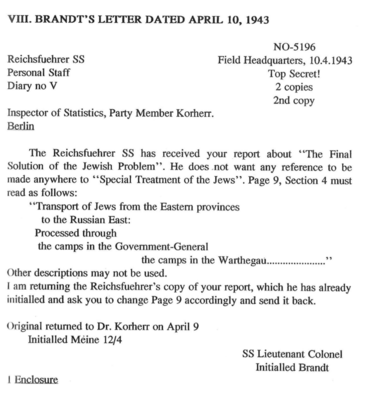Lamprecht wrote:Those questions are relevant to what I interpret your position as, which is: the post-war testimony of Jews from Transnistria, which have nothing to do with Belzec, support the position that hundreds of thousands of Jews were dumped into pits at Belzec.
I agree it doesn't evidence anything about Belzec. I brought it up because I think it shows shows that resettlement of Jews in occupied USSR would indeed generate extensive witness testimony, documents, etc.
I understand you have some questions about the evidence here so I think I'll make a separate thread for this.
Not sure. Do you believe over half a million Jews were dumped into massive pits at Belzec?
My feeling is similar to what David Irving believes (short answer: it happened) but I am open to hearing your reasons for why it didn't, or if you could direct me towards a good source or thread.
Since this is the code words thread, I'll get back to some of your previous questions
Ok. So you believe that the utilization of "code words" in documents solely for the purpose of post-war deception was practiced?
Not solely. There are few other reasons. There's a definite crossover between coded language and euphemistic, eg see the 'made harmless' descriptor used in the document I posted earlier about Jews being transported to Belzec. Authors understandably wouldn't have wanted to incriminate themselves by showing involvement in dubious activities.
Finally, and most importantly, there was the need for internal secrecy. This way the Korherr report could be passed around to civilian agencies without alerting them to any mass killing program.
You do also accept that these Eastern camps were described as being part of a program of resettlement in multiple documents, yes?
If I'm not mistaken only 3 documents even vaguely evidence this position. The first is the Korherr report, the second Himmler mentioning Sobibor as a transit camp in 1943, and the third is the 'unemployable Jews go to Belzec'
This document + a related one illustrates my point internal secrecy pretty well so I'll post the entire thing plus a related document.
The information came from Fritz Reuter, who worked in the department of Richard Turk (civilian) which was helping with deportations.
I arranged for a talk with Hstuf. Höfle for Monday, the 16th of March 1942, namely at 17:30 hours. In the course of the discussion the following was explained by Hstuf. Höfle:
It would be expedient to divide the transports of Jews arriving in the Lublin district already at the station of departure into employable and unemployable Jews. If it is not possible to make this distinction at the station of departure, one must eventually pass on to separating the transport in Lublin according to the aspects mentioned above.
Unemployable Jews are all to come to Bezec [Bełżec], the outermost border station in the Zamosz district.
Hstuf. Höfle is thinking of building a large camp, in which the employable Jews can be registered in a file system according to their occupations and requested from there.
Piaski is being made Jew-free and will be the collection point for the Jews coming out of the Reich.
Trawnicki [Trawniki] for the present time is not occupied by Jews.
H. asks where on the Dęblin-Trawnicki route 60,000 Jews can be unloaded. Informed about the Jewish transports now running as far as we are concerned, H. explained that of the 500 Jews arriving in Susiec, those who were unemployable could be sorted out and sent to Bezec. According to a teletype of the government of March 4, 1942, a Jewish transport, whose destination was the Trawnicki station, is rolling out of the Protectorate. These Jews are not unloaded in Trawnicki, but have been brought to Izbiza. An inquiry of the Zamosz district, asking to be able to request 200 Jews from there for work, was answered in the affirmative by H.
In conclusion he stated that he could accept 4-5 transports daily, of 1,000 Jews with the destination station of Bezec. These Jews would go across the border and would never come back into the General Gouvernement
Source: Józef Kermisz, Dokumenty i Materiały do dziejów okupacji niemieckiej w Polsce, Tom II, "Akce" i "Wysiedlenia," Warsaw-Lodz-Krakow 1946, p. 32 [Quoted in the book by Mattogno and Graf: Belzec, p. 103]
On 20 March, Türk wrote a note about the meeting between Höfle and 2 Kreishauptmann
Kreishauptmann Weienmeyer has as yet been able to learn nothing about final outcome of the deportation; all that is known is the existence of a collection camp some distance from the Belzec train station on the district border, that is entirely closed off, and the arrival of a SS-commando of some 60 men.
Source: Türk notes, 20 March 1942. YVA O-53/79/476
The second document obviously isn't evidence of murderous activities at Belzec, but rather secrecy surrounding the camp. We can see in Globocnick's letter of 1944 that all documentation "vouchers" related to the camps were destroyed, equipment removed, and "surveillance" farms built on the sites. Indeed documentation related to the construction and function of these camps is nearly non-existent.
The Reuter document therefore doesn't contradict the orthodox narrative, unless you are arguing it would be necessary and prudent for the SS to tell civilian agencies within the borders of Poland about any genocidal program.



